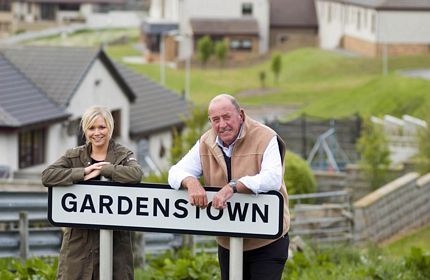In the RSP’s interview with Joe Webster, listeners are treated to rich ethnographic data which reveal how an immediate ‘local’ context is embedded in ‘global’ processes and networks. Webster conducted his fieldwork in the fishing village of Gardenstown or ‘Gamrie’ in Aberdeenshire, in the north-east of Scotland. Its population are notable for the concentration of followers of offshoots of the movement known as the ‘Plymouth Brethren’, or simply ‘Brethren’[1].
Both the local context and the Brethren movement generally are far from my areas of expertise, my own research concerns the contemporary relationship between ‘religious’ (including ‘non-religious’) affiliations and various constructions of ‘Scottish national identity’. In this regard I hope I can at least place Webster’s research in the wider social and historical context, the ‘national level’ alongside the ‘local’ and ‘global’ ones.
If one considers the question of how the Gamrie Brethren ‘fit into’ the wider picture of religion in Scotland, they would not appear to ‘fit’ at all. According to the latest census, conducted in 2011, only 54% of respondents identified as ‘Christian’, 16% identifying as ‘Roman Catholic’[2], and of the majority of this Christian population who could be classified as ‘Protestant’, it is difficult to gauge how many would have much in common with the Brethren – I suspect relatively few. This is novel for a country with an immensely long and complicated Christian history and which was long associated with staunch Protestantism.
While Scotland does possess an official national Church (the Church of Scotland), it could be quite accurately described as for the most part highly secularised. Along with this, religious pluralism has become part of the system of norms inculcated in Scottish civil society, despite the comparatively low numbers of non-Christian religious minorities.
In many ways this image of Scotland as secular and pluralist is that which many contemporary Scots project, a reflection both of their norms and experiences. As Benedict Anderson argued, nations are imagined communities, though the community that is imagined can vary immensely over time and in the present[3].
While much of Scotland’s romantic symbolism may be derived from the Highlands and many areas have contributed to the Scottish imagination, arguably the dominant perspective is that of the ‘central belt’. That is the area of the country dominated by its two biggest cities – Edinburgh and Glasgow; the centres of politics, business, the media, and, to large extent, ‘national’ religious institutions. Notably these cities have high concentrations of ‘non-religious’ people and are more religiously plural, meaning that a city-dweller may be more likely to attend a local Diwali celebration than a Gamrie Brethren service. As Anderson argued, ‘members’ of nations could never hope to personally interact with all who claim or are claimed to be members of the nation, which can help smooth over differences and affect the imaginative process[4].
However this does not mean that the Gamrie Brethren are necessarily representative of ‘traditional’ Scottish religion either. The movement was founded in Plymouth by an Irish medical student and would have to be implanted in this local Scottish soil. I cannot help but share the intuitive reaction of the interviewer (David Robertson) in being struck by the sense in which the movement and its religious practices appear more stereotypically ‘American’ to myself as someone raised in Scotland, than stereotypical of rural Scotland. The calls to emotional testimony of personal experience certainly do not fit the dour Calvinism stereotype of Scottish religion. Alive and well, living in Aberdeenshire and speaking Doric[5] it is though–regardless of how well it fits some preconceived image.
This cautions us against treating rural religion as an unbroken ‘survival’ of a bygone age; at the very least the Brethren could not have come to Gamrie earlier than 1831 when the movement was founded, and I would expect a much later date. Regardless, the Brethren have clearly been able to fundamentally shape life in the village down to the level of everyday interaction, and it is notable that the local branch of the ‘national’ Church has been moulded into the local ‘Brethren’ image.
Nonetheless, their case is not as atypical as it might first appear. Without intending to essentialise, such cases have a long history in Scotland. Much of northern Scotland, especially, is rugged and rural and perhaps encourages the development of pockets of concentrated difference from the norms disseminated from the centre. When Presbyterian Calvinism was ascendant in the south, much of the north was Episcopalian with pockets of Roman Catholicism. Radical Calvinistic Presbyterianism began to take root in parts of the Highlands and continued to thrive when it began to fall from favour in the south, etc.
Webster related how the Brethren’s religious practices have led many of them to utilise Christian media, much of which is based in the US. Steve Bruce has argued that religious conservatives in Scotland did not develop the kind of alternative networks set up by their US counterparts because they were simply oblivious to the changes going on underneath their feet[6]. Nonetheless, clearly, expanding global communications have allowed the Gamrie Brethren to take advantage of such networks, which, in turn, inform the local context.
This religious context may be rural and divergent from the current Scottish norm (in both senses of the word) but this does not make it a product of isolation, and, in fact, appears to be as caught up in wider developments as central belt secularism. However, these global links clearly attain specific local significance. Webster’s informants not only see the power of God and the Devil working in their daily lives but also in the political relationship between the fishing communities of the north-east and the European Union.
Over the course of the interview, the question of how the Gamrie Brethren view themselves in relation to Scottish national identity and modern Scottish society was never broached as such. One would certainly not want to presume that it is significant at all; the local setting and transnational Evangelical networks may be of much greater significance. Webster has indicated that religious decline did not appear to trouble his informants who viewed it as indicative of end times. Scottish secularism may be viewed in similar terms. They may draw comfort and significance from the history of Scottish Protestantism, its leading figures such as John Knox and the Covenanter rebels, as many Scots did and still do. The advantage of a long and untidy history is there are plenty of ‘Scotlands’ to choose from. Clearly dealing with the religious landscape of the country in the present offers up no less diversity.
Bibliography
Anderson, B. Imagined Communities (2006) London: Verso
Bowker, J. The Oxford Dictionary of World Religions (1997) Oxford: Oxford University Press
Broun, D., Finlay, R.J. and Lynch, M. (eds.) Image and Identity: The Making of Scotland through the Ages (1998) Edinburgh: John Donald Publishers Ltd
Brown, C. Religion and Society in Scotland since 1707 (1997) Edinburgh University Press
Bruce, S. No Pope of Rome: Anti-Catholicism in Modern Scotland (1985) Edinburgh: Mainstream Publishing
Devine, T.M. The History of the Scottish Nation 1700-2000 (2000) London: Penguin Books Ltd.
National Records of Scotland 2011 Census: Key results on Population, Ethnicity, Identity, Language, Religion, Health, Housing and Accommodation in Scotland – Release 2A (2013) Crown Copyright 2013
[1] C.f. “Plymouth Brethren” in Bowker, J. (ed). Oxford Dictionary of World Religions (1997) Oxford: Oxford University Press: p756
[2] National Records of Scotland 2011 Census: Key results on Population, Ethnicity, Identity, Language, Religion, Health, Housing and Accommodation in Scotland – Release 2A (2013) Crown Copyright 2013: p5
[3] Anderson, B Imagined Communities (2006) London: Verso: p5-6
[4] ibid
[5] ‘Doric’ is the name of the highly specific form of Scots or Lallans spoken in the region.
[6] Bruce, S No Pope of Rome: Anti-Catholicism in Modern Scotland (1985) Edinburgh: Mainstream Publishing: p216



